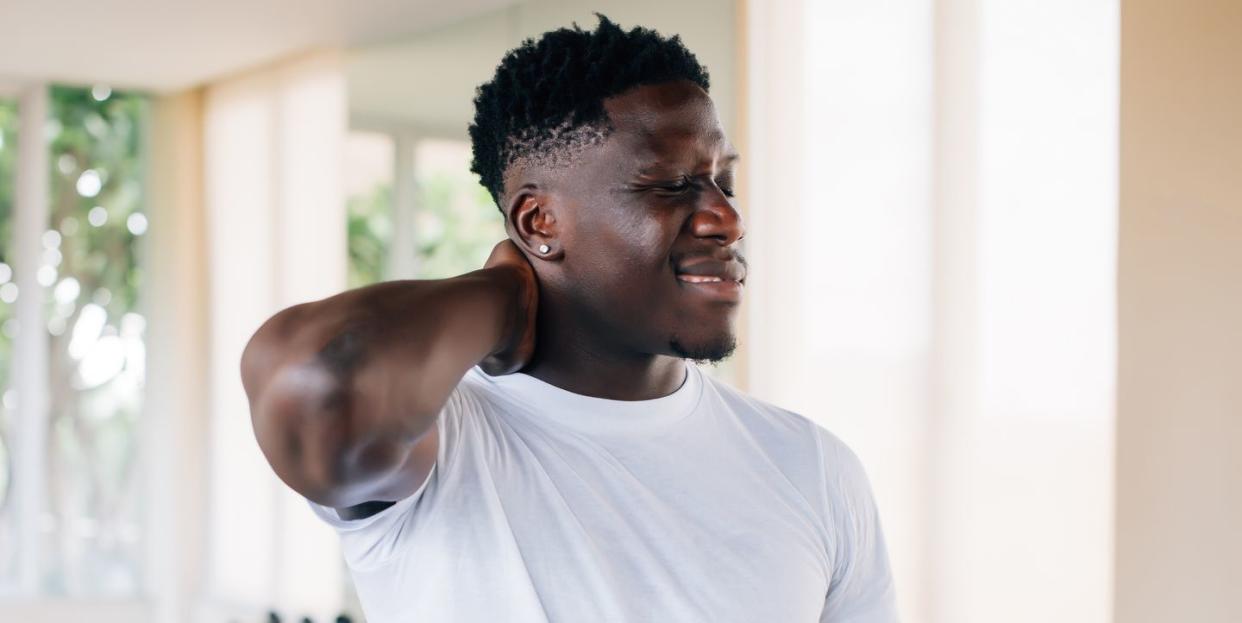4 Ways to Quickly Relieve That Pain in Your Neck

When you think about fixing your posture and the pain that comes from spending all day hunched over your computer during work and your trainer during workouts, the first thing to come to mind might be your lower back. But, one thing that isn’t always a focus for better posture—your neck.
Despite using your neck constantly throughout the day, nobody pays much attention to it unless there’s pain—and neck pain is extremely common. Chances are you and just about everyone you know has experienced some form of neck pain in the past year.
The average human head weighs 10 to 11 pounds. That’s more than 5 percent of the average man’s total bodyweight, according to the CDC. While the rest of your body is supported by large muscles in the legs, torso and shoulders, your head is controlled and supported by many much smaller muscles in the neck.
The neck, or cervical spine, is the highest portion of the spine. It consists of seven vertebrae and 26 muscles, among many other structures such as blood vessels and nerves. It moves and stabilizes the head and serves as a passageway for the rest of the body to connect with the brain.
The posture that we use when looking at cell phones, laptops, and even reading books can lead to sustained forward head positioning, which often contributes to weakness and pain in the neck. Untreated neck pain can lead to other problems such as headaches, jaw pain and even shoulder or back pain.
[Want to fly up hills? Climb! gives you the workouts and mental strategies to conquer your nearest peak.]
Unfortunately, neck muscles are typically ignored in most workouts. Not only are these muscles smaller than most of your other muscles, they are also often hard to target. Most people don’t even know where to begin if they wanted to strengthen this unappreciated body part. Luckily, just a few exercises, stretches, and soft tissue release techniques can provide some quick relief.
Your Move:
Strengthen
Try chin tucks (or cervical retraction) to strengthen the deep cervical flexors. Begin lying down. Gently tuck your chin in towards your neck, to create a double chin. You should feel a stretch at the base of your skull and an activation of muscles in the front of your neck. Hold this exercise for 5 to 10 seconds and repeat 8 to 10 times daily. For a bigger challenge, try lifting the head slightly off the table while maintaining this position and hold for 10 seconds each time.
Stretch
The upper traps, scalenes, and sternocleidomastoid are all muscles that often get tight in the neck. Start by stretching the upper traps. While standing or sitting, bring one ear to your shoulder and applying gentle overpressure with your hand. Hold this stretch for up to 30 seconds. Repeat on opposite side.
Release
If you feel there is a “knot” or trigger point, or an area of that is specifically painful or tight, try self releasing with a foam roller, massage or (carefully) with a massage gun. Apply direct pressure for about 10 seconds then release to promote blood flow to the area.
Posture
While standing or sitting, try to avoid sustained positions with the head tilted downward or the chin jutting out. Think about the chin tuck exercise while you’re sitting or standing and try lengthening your neck, as if someone was pulling a string from the top back of your head up towards the ceiling.
You Might Also Like

